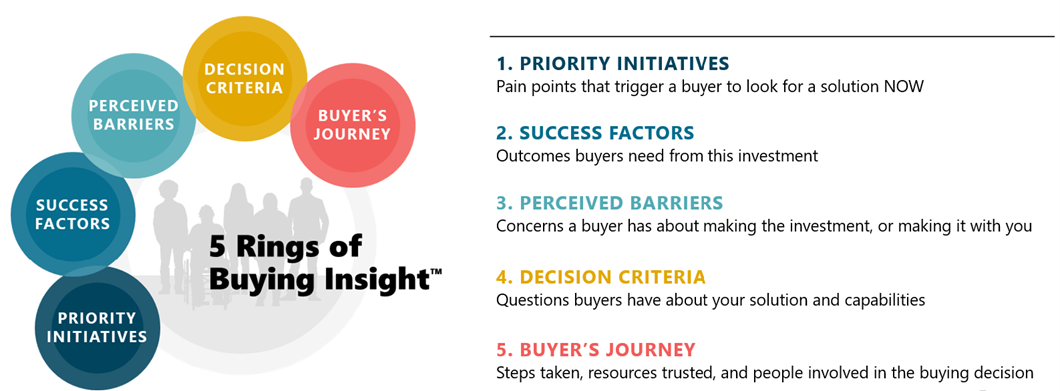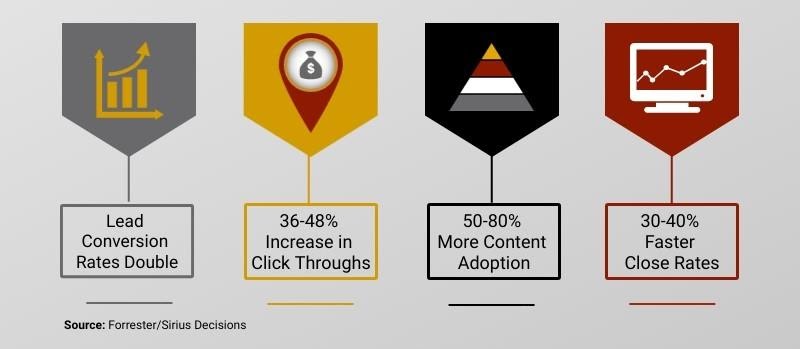We are often asked about the value of conducting survey research to validate and enhance Buyer Persona insights developed from one-on-one interviews with buyers. Based on the hundreds of studies we’ve been involved in, there has never been an instance where survey research invalidated the buyer insights from the initial interviews. However, survey research can increase your confidence in the findings and enhance them in several important ways.
Conduct One-On-One Interviews to Build Your Buyer Persona
If you’re a marketer and have taken the time and effort to develop a Buyer Persona based on one-on-one interviews with prospective buyers, you’re in a terrific spot.
These “qualitative” interviews give your prospective buyers the time to talk about their entire journey—from the moment they have an initial need for a solution that you offer until the time they make a final buying decision.
Fresh from the often-harrowing experience of days, weeks, months, or, perhaps, even years dominated by the search for a solution to their problem, buyers can articulate exactly what triggered them to begin, and with the right prompting, reveal incredible details about what transpired as they cast a wide net for all available options before they ultimately chose one.
By looking for patterns in the data across these interviews, they reveal exactly what your prospective buyers need to know and experience to have confidence buying your solution.
Based on the 5 Rings of Buying InsightTM, these Buyer Persona insights take all the guesswork out of your marketing, enabling you to develop strategies, content, and messaging that connects with buyers, breaks through the clutter, and drives more sales.

Read In-Depth Breakdown of the 5 Rings of Buying InsightTM for Buyer Personas here.
Enhance Your Buyer Persona with Survey Research
If these one-on-one interviews are the foundation of your Buyer Persona house, think of survey research as the framing, drywall, plumbing, and electricity that make the house even more useful. Conducting a survey with a larger number of buyers will validate, refine, and extend your Buyer Persona insights so you can make even better decisions about how to influence them.
Here’s four ways that survey research will enhance your Buyer Persona insights:
1. Confirm the Accuracy and Validity of Your Buyer Persona
Surveying a larger number of buyers increases the statistical validity that the buyer expectations you identified from your initial interviews are accurate and representative of the markets you’re targeting. For some organizations, that increased level of comfort is worth the extra time and resources needed to complete this additional step, particularly when your Buyer Persona is the foundation of your marketing strategies and messaging.
There are various ways to achieve this in a survey but asking buyers a mix of open-ended questions (free-form responses) and closed-ended questions (e.g., ratings, rankings, select from a list of choices, etc.) does the job well. You can do this for each of the 5 Rings of Buying InsightTM or pick-and-choose if there are certain insights you’re more focused on than others.
For example, let’s say a healthcare MRI machine manufacturer interviews recent buyers of MRI machines and develops a Buyer Persona for this buying decision. Here are two questions they can ask in a survey to confirm each Success Factor identified from the initial interviews.
Q1. In the space below, please indicate all the important outcomes or benefits you are expecting from this MRI machine purchase.
_______________________________
Q.2 On a 10-point scale, where “1” is “not at all important” and “10” is “very important”, to what extent is each of the following an important outcome that you need from a new MRI machine? (Rate Each)
- Improve image quality
- Better retain existing patients
- More easily acquire new patients
- Improve staff productivity through faster scans
- Improve patient comfort through a quieter and roomier machine
- Expand our operations by performing additional procedures
- Reduce expenses
| Not at All Important |
Very Important |
||||||||
| 1 | 2 | 3 | 4 | 5 | 6 | 7 | 8 | 9 |
10 |
| O | O | O | O | O | O | O | O | O |
O |
Q1 is an open-ended question where buyers have the opportunity to speak (if a phone survey) or type in (if an online survey) their response. It eliminates the risk that buyers will be influenced by any of the Success Factors listed in Q2.
Q2 is a close-ended question where buyers rate each of the seven Success Factors on a 10-point scale. By asking Q2, you’ll also get direct input on each of the seven Success Factors. Since these were identified from the one-on-interviews, there is a strong likelihood that all or most will be regarded as important to buyers, but this is the opportunity to validate that assumption.
Click here for buyer personas examples.
2. Determine Which Buyer Expectations are the Most Important
Not all buyer expectations are created equal—there are assuredly some that are more important than others. Through survey research, you have an opportunity to identify which buyer expectations are the most (and least important) in their buying decision. This is often referred to as “relative importance” since the importance of something is considered relative to something else.
For example, let’s say eleven Decision Criteria are identified in the MRI machine Buyer Persona. The MRI machine manufacturer should develop strategies to address each of these questions since buyers use them to evaluate the options, and each is likely to come up at some point in their buying journey. However, it’s also reasonable for them to ask which of the eleven Decision Criteria are the most important to buyers to prioritize their marketing activities, messages, and resources.
Here are four different ways to determine the relative importance of the eleven Decision Criteria:
- Select Top One or Two: Have buyers select the top one or two Decision Criteria that are the most important in their buying decision out of the eleven. It’s also useful to ask buyers which one or two are the least important and report on those results as well.
- Rankings: Have buyers rank the eleven MRI machine Decision Criteria from one (most important) to eleven (least important).
- Chip Allocation: Have buyers allocate 100 “chips” (or points) across the eleven Decision Criteria. The more chips a buyer allocates to a Decision Criteria, the more important it is. You can allocate as many or as few chips as you want to each of the eleven Decision Criteria.
- Choice-Based Exercise (such as Maximum Difference Scaling): Have buyers go through a series of questions, like the one below, where they indicate which Decision Criteria is the MOST important in their buying decision and which is the LEAST important. Using this approach, buyers answer a series of questions where four of the eleven Decision Criteria randomly appear on the screen (in the case of an online survey). The survey will continue to ask and collect which is the MOST and LEAST important. You can typically gather all the survey data you need by having buyers answer four to six questions just like this (one after another) where the four options vary randomly from question to question.
Example of a Choice-Based Survey Question
|
Of the following, which is the MOST important and which is the LEAST important in terms of which MRI machine you will purchase? |
||
|
MOST Important |
LEAST Important |
|
| Image quality (sharp, clear, detailed) |
O |
O |
| The speed of scan sequences |
O |
O |
| How quickly the machine can be installed |
O |
O |
| Responsive and effective post-sale technical support |
O |
O |
The Chip Allocation and Choice-Based approach, require a bit more analytical sophistication to use, but have the advantage of revealing the importance of buyer expectations both hierarchically and by order of magnitude (how much more important one Decision Criteria is versus another).
3. Test Value Proposition and Market Messaging Concepts
One of the first things that organizations do after developing a Buyer Persona is refresh their market messaging or develop entirely new messaging altogether. Once you develop the messages, survey research provides a great opportunity to test them with prospective buyers before you start using them in the market. By doing so, you will identify which messages influence buyers the most and gain additional insights to fine tune them for success.
Let’s stick with the MRI machine example. Based on the Buyer Persona, an MRI machine manufacturer might develop the following four message concepts focused on reducing scan times:
- In an independent study, our MRI machine produced images that are at least two times faster than any other machine on the market
- By reducing scan times, you will improve patient satisfaction and increase the number of appointments you can handle on a daily basis
- Our 3.0 Tesla magnet, intuitive user interface, and efficient workflows enables you to get patients in-and-out of appointments more quickly
- Faster imaging sequences will improve the productivity of your clinicians and image technicians
Here are four different ways to test these messages in a survey:
- Ratings: Have buyers rate each message on a 10-point scale for things such as:
- Clarity—how clear and well understood the message is
- Relevance—how well the message aligns with buyer needs
- Differentiation—how different or unique the message is
- Compelling—to what extent the message sparks a buyer’s interest in your solution
- Select the Top Message: From a set of messages, have buyers select the one that is the most important (or influential) in their buying decision.
- Ranking: From a set of messages, have buyers rank each of them from most to least important in their buying decision.
- Choice-Based Exercise: Described earlier, this approach is perfectly suited to test message concepts because buyers select which is the MOST important and the LEAST important in their buying decision.
Learn more about using survey research to enhance your Buyer Personas here.
4. Identify and Understand Buyer Segments
When it comes to high consideration buying decisions, it’s important to understand buyer expectations across the entire buying committee. This is the core of your Buyer Persona and what the 5 Rings of Buying Insight reveal.
However, there are times when important differences in buyer expectations may exist across different “segments” of the market—such as by company size, industry, geography or a buyer’s role.
For example, if an MRI machine manufacturer targets both large hospitals and smaller independent imaging practices, it’s conceivable that some of the needs, expectations, and aspects of the buying journey could vary across these two cohorts. If they suspect that this is the case, it’s appropriate to do a deeper exploration of each of these segments in a survey. Doing so will confirm or refute their suspicions and provide the buying insights needed to tailor their marketing approach if they decide to do so.
As with most things related to survey research, there are different approaches to achieving a particular objective—in this case, identifying any meaningful differences in buyer expectations across different segments of the market. Fortunately, the approach we recommend is straightforward and can be achieved in three steps:
- First, complete enough survey interviews in each segment so a reliable evaluation can be made between them. If you’re working with your in-house market research team or a third-party research firm, they can help you determine how many survey completes are enough, but the important thing is to design the study so you have a sufficient number in each segment to analyze the results within them.
- Second, complete a thorough side-by-side comparison of results between the segments in your study. This should be done across buyer expectations for each of the 5 Rings of Buying Insight.
- Third, based on this comparison, and your own capabilities, decide whether or not it’s worthwhile to tailor your marketing and sales approach within certain market segments.
- If there are meaningful differences between the segments that your company has unique capabilities to address, take a more tailored marketing approach to each segment accordingly.
- If there are no significant differences between segments, or your company doesn’t have unique capabilities to address any of the identified variances, then take one, consistent approach to both segments.
Conclusion
Surveys are one of the most popular forms of market research and a great way to validate and enhance Buyer Persona insights. None of the four areas above are a must; you have the flexibility to focus a survey on whatever buying insights you think would be the most worthwhile. However, in our experience, these are the areas that provide the most useful learnings because they bolster stakeholder confidence in your Buyer Persona and provide additional buying insights that enable you to market and sell to buyers even more effectively.
Need Help Building Your Buyer Personas? Let’s Talk!





